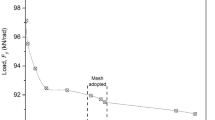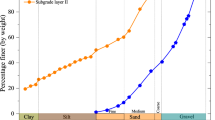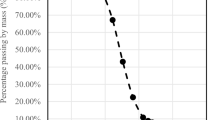Abstract
The expansive soils pose lot of problems due to their behaviour of swelling/shrinkage upon wetting or drying. Most part of central India and southern India is covered with layers of expansive soils. Due to the increase in population and increase in per capita demand of land, engineers have to construct various high rise structures on expansive soils which generally pose cracking problems in the buildings. Granular pile anchor is a new technique generally adopted to enhance the uplift resistance of poor expansive soils, such as loose sands, soft clays, black cotton clays etc. This paper presents a numerical study to predict the uplift performance of granular pile anchors (GPA) in expansive soil using 3D finite element PLAXIS software. The effect of length (L), diameter (D), and number of the GPA at different spacing (S) values on uplift capacity is analysed by applying prescribed displacement of 10% of pile diameter at the centre of granular pile anchor. Further, length to diameter (L/D) ratio of single pile and group pile was analysed using different parameters. The resistance of granular pile anchors against uplift forces with variation of modulus of elasticity of soil is also analysed. Based on the numerical analysis, it is observed that the uplift capacity of granular pile anchor increased with increase in length and diameter of pile for both single pile and piles arranged in a group. Further, on increasing value of modulus of elasticity of soil, there is increase in pullout resistance. The efficiency of GPA is also evaluated which helps in the selection of various parameters of granular pile anchor.














Similar content being viewed by others
References
Subba Rao KS (1999) Swell–shrink behaviour of expansive soils—geotechnical challenges. Indian Geotech J 30(3):1–69
Chen FH (1980) Foundations on expansive soils. Elsevier Scientific, Amsterdam
Nelson DJ, Miller JD (1992) Expansive soils—problems and practice in foundation and pavement engineering. Wiley, New York
Satyanarayna B (1966) Swelling pressure and related mechanical properties of black cotton soils. Ph.D. thesis, Indian Institute of Science, Bangalore, India
Mowafy YM, Nagy AH (2001) The effect of reinforced sand cushion on the behavior of expansive soil using large scale apparatus. J Geotech Eng
Phanikumar B (2009) Expansive soils—problems and remedies. GEOTIDE, Indian geotechnical conference, Guntur, pp 907–913
Katti R (1979) Search for solutions for problems in black cotton soils. Indian Geotech J 9(1):1–80
Rao A (1984) A study of swelling characteristics and behavior of expansive soils. Ph.D. thesis, Kakatiya University, Warangal, India
Hunter D (1988) Lime-induced heave in sulfate-bearing clay soils. J Geotech Eng 114(2):150–167
Sankar N (1989) Use of lime–soil piles for in situ stabilization of black cotton soils. In: Proceedings of Indian geotechnical conference, vol 1, pp 149–153
Petry TM, Little DN (1992) Update on sulfate-induced heave in treated clays; problematic sulfate levels. Transportation Research Record 1362, pp 51–55
Kumar V (1996) Fly ash utilization: a mission mode approach: ash ponds and ash disposal systems. Narosa Publishing House, New Delhi
Rollings M, Rollings R (1996) Geotechnical materials in construction. McGraw-Hill, New York
Desai I, Oza B (1997) Influence of anhydrous calcium chloride on shear strength of expansive soils. In: Proceedings of 1st international symposium on expansive soils, HBTI, Kanpur, India
Rollings R, Burkes J, Rollings M (1999) Sulphate attack on cement-stabilized sand. Aus J Geod Photogr Surv 125(5):364–372
Phanikumar B (2000) Use of fly ash in treating problematic expansive soils. In: Proceedings of workshop on environment and geotechnics. Indian Geotechnical Society, Hyderabad, pp 36–39
Cokca E (2001) Use of class C fly ash for the stabilization of an expansive soil. J Geotech Geoenviron Eng 127(7):568–573
Phanikumar BR, Reddayya SN (2001) Swelling characteristics of fly ash-treated expansive soils. In: Proceedings of international symposium on suction, swelling, permeability, and structure of clays, IS Shizuoka, Japan, pp 121–123
Phanikumar B, Sharma R (2004) Effect of fly ash on engineering properties of expansive soils. J Geotech Geoenviron Eng 130(7):764–767
Acosta H, Edil T, Benson C (2013) Soil stabilization and drying using fly ash. Geotechnical engineering, Report no. 03-03, Department of Civil and Environment Engineering, University of Wisconsin-Madison, Madison, WI
Hoyos L, Puppala A, Chainuwat P (2004) Dynamic properties of chemically stabilized sulphate rich clay. J Geotech Geoenviron Eng 130(2):153–162
Leite FDC, Motta RDS, Vasconcelos KL, Bernucci L (2011) Laboratory evaluation of recycled construction and demolition waste for pavements. Constr Build Mater 25:2972–2979
Sharma RK, Hymavathi J (2016) Effect of fly ash, construction demolition waste and lime on geotechnical characteristics of a clayey soil—a comparative study. Environ Earth Sci J 75(377):1–11
Setty K, Ravi SA, Manohar C (1966) Behaviour of under-reamed piles in Shedi soil. In: Proceedings of IGC-96, Madras, India, vol 1, pp 286–289
Sharma D, Jain M, Prakash C (1978) Handbook on under reamed and bored compaction pile foundations. Central Building Research Institute, Roorkee
Babu Shanker N, Appayanna M, Shankaraiah B (1980) Design and testing of under—reamed piles. In: Proceedings of geotechnical conference, Bombay, vol 1, pp 203–206
Rao BG (1980) What techniques other than under-reamed piles have proven to be effective in minimising foundation problems in black cotton soils?—Response paper to the question. Indian Geotech Conf New Delhi 2:145–149
Dey A, Minda R, Gurung K (1996) A case study on under-reamed piles. In: Proceedings of 6th international conference and exhibition on piling and deep foundations, Bombay
IS: 2911 (Part III) (1980) Indian standard code of practice for design and construction of pile foundations, under—reamed piles. Bureau of Indian standards, New Delhi
Poulos H, Davis E (1980) Pile foundation analysis and design. Wiley, New York
Dinesh M (1991) Pile foundations. Oxford and IBH Publishing Corporation Private Limited, Delhi
Subba Rao KS (1991) Swell–shrink behaviour of expansive soils—geotechnical challenges. Indian Geotech J 27(3):1–69
Kranthikumar A, Sawant V, Kumar P, Shukla S (2017) Numerical and experimental investigations of granular anchor piles in loose sandy soil subjected to uplift loading. Int J Geomech 17(2):1–10
Rao BG (1982) Behaviour of skirted granular piles. Ph.D. thesis, University of Roorkee, Roorkee, India
Ranjan G (1989) Ground treated with granular piles and its response under load. Indian Geotech J 19(1):1–86
Greenwood D (1970) Mechanical improvement of soils below ground surface. In: Proceedings of ground engineering conference, Institute of Civil Engineering, London, pp 9–20
Hughes J, Withers N (1974) Reinforcing of soft cohesive soils with stone columns. Ground Eng 17(3):42–49
Datye K, Nagaraju S (1981) Design approach and field control for stone columns. In: Proceedings of 10th international conference on soil mechanics and found engineering, Stockholm
Ranjan G, Rao BG (1986) Skirted granular piles for ground improvement. In: Proceedings of 8th European conference on soil mechanics and found engineering, Helsinki
Deb K, Basudhar PK, Chandra S (2007) Generalized model for geosynthetic-reinforced granular fill-soft soil with stone columns. Int J Geomech 4:266–276
Deb K, Shiyamalaa S (2015) Effect of clogging on rate of consolidation of stone column-improved ground by considering particle migration. Int J Geomech 16:1943–5622
Phanikumar B, Prasada G, Srirama A (1994) Use of anchored granular column in minimising swell in expansive clays. In: Proceedings of Indian geotechnical conference, Warangal, India, pp 61–65
Phanikumar B (1997) A study of swelling characteristics of and granular pile anchor foundation system in expansive soils. Ph.D. thesis, Jawaharlal Nehru Technological University, Hyderabad, India
Phanikumar B, Sharma RS, Srirama RA, Madhav MR (2004) Granular pile anchor foundation (GPAF) system for improving the engineering behavior of expansive clay beds. Geotech Test J 27(3):279–287
Srirama A, Phanikumar B, Dayakar R, Suresh K (2007) Pullout behavior of granular pile-anchors in expansive clay beds in-sit. Geotech Geoenviron Eng 133(5):531–538
HariKrishna P, Murthy V (2013) Pull-out capacity of granular anchor piles in expansive soils. IOSR J Mech Civ Eng 5(1):24–31
HariKrishna P (2006) A study on the use of granular anchor piles to control heave of footings resting on expansive soil. Ph.D. thesis submitted to Kakatiya University, Warangal
Kranthikumar A, Sawant V, Shukla S (2016) Numerical modeling of granular anchor pile system in loose sandy soil subjected to uplift loading. Int J Geosynth Ground Eng 2(15):1–7
HariKrishna P, Murthy V, Nachiappan P (2013) Pull out behaviour of granular anchor piles—FEM approach. Indian Geotechnical Conference, Roorkee, pp 1–4
Ismail M, Shahin M (2011) Finite element analyses of granular pile anchors as a foundation of granular pile-anchor foundations (GPAF) in reactive soils. Int J Geotech Eng 6(2):149–155
Ibrahim SF, Aljornay AN, Aladly AI (2014) Heave behaviour of granular pile anchor-foundation (GPA-foundation) system in expansive soil. J Civ Eng 4(3):213–222
Phani Kumar B (2013) Influence of geogrid reinforcement on pullout response of granular pile-anchors (GPAs) in expansive soils. Indian Geotech J 46(4):437–444
Randolph M, Carter J, Wroth C (1979) Driven piles in clay—the effects of installation and subsequent consolidation. Geotechnique 29(4):361–393
Gibson R, Anderson W (1961) In situ measurement of soil properties with the pressure meter. Civ Eng Public Works Rev 56(658):615–618
McCabe B, Killeen M, Egan D (2008) Challenges faced in 3-D finite element modelling of stone column construction. In: Proceedings of joint symposium on concrete research and bridge and infrastructure research in Ireland, Galileo Editions, Galway, Ireland, pp 393–400
Author information
Authors and Affiliations
Corresponding author
Rights and permissions
About this article
Cite this article
Abhishek, Sharma, R.K. A Numerical Study of Granular Pile Anchors Subjected to Uplift Forces in Expansive Soils Using PLAXIS 3D. Indian Geotech J 49, 304–313 (2019). https://doi.org/10.1007/s40098-018-0333-3
Received:
Accepted:
Published:
Issue Date:
DOI: https://doi.org/10.1007/s40098-018-0333-3




